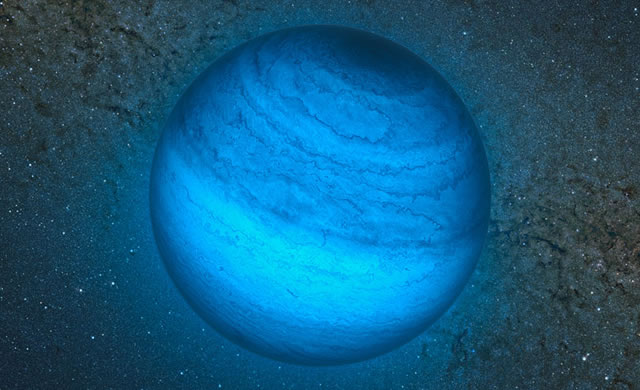
Un mondo orfano può aiutarci a comprendere come si formino stelle e pianeti.
Gli astronomi, usando il VLT (Very Large Telescope) dell’ESO e il telescopio CFH (Canada-France-Hawaii Telescope) hanno identificato un corpo celeste che molto probabilmente è un pianeta che vaga per lo spazio senza una stella madre. Questo è il candidato pianeta interstellare più interessante e finora il più vicino al Sistema Solare, a una distanza di circa 100 anni luce. La sua relativa vicinanza e l’assenza di una stella molto brillante vicino ad esso ha pemessso all’equipe di studiarne l’atmosfera in gran dettaglio. Questo oggetto fornisce agli astronomi un’anticipazione degli esopianeti che gli strumenti futuri fotograferanno intorno a stelle diverse dal Sole.
I pianeti interstellari sono oggetti di massa planetaria che vagano per lo spazio senza legami gravitazionali con una stella. Alcuni possibili esempi di questo fenomeno sono già stati trovati nel passato, ma senza conoscere la loro età non è stato possibile capire se fossero realmente pianeti o nane brune – stelle “mancate”, senza la massa minima che serve per innescare le reazioni che fanno splendere le stelle. Gli astronomi ora hanno scoperto un oggetto, chiamato CFBDSIR2149, che sembra far parte di una “corrente” di stelle vicine, nota come Associazione AB Doradus. I ricercatori hanno scoperto l’oggetto nelle osservazioni effettuate dal telescopio CFHT (Canada France Hawaii Telescope) e hanno sfruttato la potenza del VLT dell’ESO per esaminarne le proprietà. L’Associazione AB Doradus è il gruppo di questo tipo più vicino al Sistema Solare. Le sue stelle si muovono insieme nello spazio e si pensa che si siano formate contemporaneamente. Se l’oggetto è veramente associato a questo gruppo – e perciò è un oggetto giovane – è possibile dedurre molte informazioni, tra cui la sua temperatura, la massa e la composizione dell’atmosfera. Rimane una piccola probabilità che l’associazione con il gruppo sia casuale.
Fonte/Leggi tutto → ESO.org
Orphaned world may help to explain how planets and stars form
Astronomers using ESO’s Very Large Telescope and the Canada-France-Hawaii Telescope have identified a body that is very probably a planet wandering through space without a parent star. This is the most exciting free-floating planet candidate so far and the closest such object to the Solar System at a distance of about 100 light-years. Its comparative proximity, and the absence of a bright star very close to it, has allowed the team to study its atmosphere in great detail. This object also gives astronomers a preview of the exoplanets that future instruments aim to image around stars other than the Sun.
Free-floating planets are planetary-mass objects that roam through space without any ties to a star. Possible examples of such objects have been found before, but without knowing their ages, it was not possible for astronomers to know whether they were really planets or brown dwarfs — “failed” stars that lack the bulk to trigger the reactions that make stars shine. But astronomers have now discovered an object, labelled CFBDSIR2149, that seems to be part of a nearby stream of young stars known as the AB Doradus Moving Group. The researchers found the object in observations from the Canada-France-Hawaii Telescope and harnessed the power of ESO’s Very Large Telescope to examine its properties. The AB Doradus Moving Group is the closest such group to the Solar System. Its stars drift through space together and are thought to have formed at the same time. If the object is associated with this moving group — and hence it is a young object — it is possible to deduce much more about it, including its temperature, mass, and what its atmosphere is made of. There remains a small probability that the association with the moving group is by chance.
Source/Continue reading → ESO.org





















